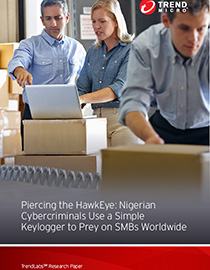Piercing the HawkEye: How Nigerian Cybercriminals Used a Simple Keylogger to Prey on SMBs
 View Piercing the HawkEye: Nigerian Cybercriminals Use a Simple Keylogger to Prey on SMBs Worldwide
View Piercing the HawkEye: Nigerian Cybercriminals Use a Simple Keylogger to Prey on SMBs Worldwide
In a typical cybercrime scheme, perpetrators sell gathered information from their victims in the cybercriminal underground and move on to launch attacks on new targets. However, in the case of the operations run independently by two Nigerian cybercriminals dubbed as “Uche” and “Okiki,” they used a simple keylogger, "Hawkeye," to scout more and bigger targets. Instead of selling the confidential data they acquired from their victims, these cybercriminals took their time to gather more knowledge about their victim’s business contacts, affiliates, and partners in order to launch scams. The tool played a crucial role in change of supplier fraud. In the said scheme, cybercriminals monitor compromised business emails and hijack transactions by sending an alternative payment details, routing the payments straight to the cybercriminals’ pockets.
[Read more about keyloggers and how they are used for cyberspying purposes in From Cybercrime to Cyberspying: Using Limitless Keylogger and Predator Pain]
This Trend Micro research paper highlights how cybercriminals are able to use unsophisticated software to execute high-impact attacks.
Stepping stones for bigger prey
The impact of an attack can depend on how cybercriminals use the data stolen from their target victims. For instance, information stolen through Hawkeye enabled the cybercriminals to expand their targets to include those who’ve done business with their original victim. In our monitoring of the victims, we observed that these companies were either related to one another or were in the same industry, most of which aresmall and medium-sized businesses located in India, Egypt, and Iran.
Apart from scouting more targets, Hawkeye was used to move laterally across large organizations. Based on our investigation, a regional office was initially targeted as a stepping stone used to get to bigger prey—the company’s global office. This goes to show that the cybercriminals employed their access to these smaller, regional offices in order to gain entry to the global office.
[Read more about Lateral Movement in targeted attacks in Lateral Movement: How Do Threat Actors Move Deeper Into Your Network?]
Covering one’s bases
The series of malware attacks launched by Uche and Okiki dispels the notion that only very large enterprises are vulnerable to cybercrime attacks. Nowadays, the size of the company doesn't matter. Everyone is a potential target. SMBs that may have a smaller budget allotted to security technology face the same security challenges and threats that enterprises encounter. As these operations proved, the security gaps within smaller companies were leveraged to jump to bigger enterprise targets.
For more details about this operation and the perpetrators behind it, read our full paper, Piercing the HawkEye: Nigerian Cybercriminals Use a Simple Keylogger to Prey on SMBs Worldwide
Like it? Add this infographic to your site:
1. Click on the box below. 2. Press Ctrl+A to select all. 3. Press Ctrl+C to copy. 4. Paste the code into your page (Ctrl+V).
Image will appear the same size as you see above.
Messages récents
- Estimating Future Risk Outbreaks at Scale in Real-World Deployments
- The Next Phase of Cybercrime: Agentic AI and the Shift to Autonomous Criminal Operations
- Reimagining Fraud Operations: The Rise of AI-Powered Scam Assembly Lines
- The Devil Reviews Xanthorox: A Criminal-Focused Analysis of the Latest Malicious LLM Offering
- AI Security Starts Here: The Essentials for Every Organization

 Complexity and Visibility Gaps in Power Automate
Complexity and Visibility Gaps in Power Automate AI Security Starts Here: The Essentials for Every Organization
AI Security Starts Here: The Essentials for Every Organization Ransomware Spotlight: DragonForce
Ransomware Spotlight: DragonForce Stay Ahead of AI Threats: Secure LLM Applications With Trend Vision One
Stay Ahead of AI Threats: Secure LLM Applications With Trend Vision One